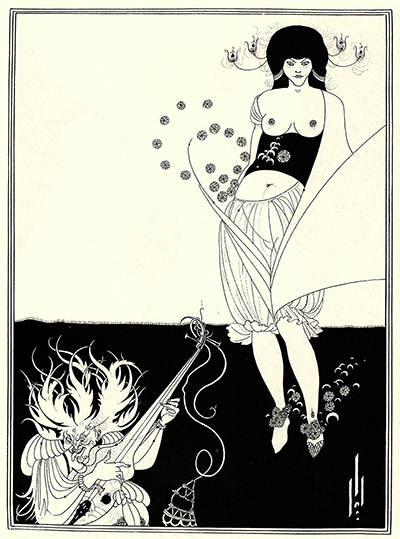The Stomach Dance is a design by Aubrey Beardsley from 1894 which formed part of his contribution to an English publication of Salome. The Dancer's Reward and The Peacock Skirt were two of the other designs in this exciting series.
He took the content of Oscar Wilde's play and produced a number of drawings in black and white which would sit alongside the texts. Several years later, a portfolio of these designs was re-printed and it is from that that many prints of these drawings exist today. The likes of the V&A and the Metropolitan Museum of Art host a large number of the artworks and some can be viewed in person, though you might need to arrange a visit prior to arrival. There have also been a number of exhbitions of the artist's work in recent years which has reminded the public about the unique body of work that Beardsley created, whilst his reputation remains strong within the graphic arts community, on which he was a major influence, particularly in his native UK. One can only imagine what he might have gone on to achieve were it not for the illness which curtailed his life at such a young age, with his professional life only lasting around six full years in total. He does, however, remain one of the most famous British draughtsman of all time and continues to be studied today.
This particular artwork features the lead character in this play, Salome, performing the dance of the seven veils. Her dress swirls around in order to communicate this movement to the viewer. Interestingly, her stomach and upper half are entirely exposed in this controversial artwork. Many of the drawings for this series were risque, with the artist forced in some cases to actually make amends in order to allow them to be accepted into the Salome book. We find the patterns of peacock feathers which Beardsley used in several works here in The Stomach Dance. The beauty of those shapes perfectly suited his style of illustration. Besides Salome herself, we also can see a figure in the bottom left corner who is playing music whilst she dances, and also some elements of nature which suggests that they are located in a garden outside. It is a fun and lively drawing, perhaps one of his best within this Salome series.
Beardsley learnt much from his time living in France and was able to combine these influences with other experiences that he had whilst in London. He would spend much of his social time in the company of other artists, exchanging ideas and this helped him to move from a budding amateur to someone who had developed a style unique to himself. He also held a confidence in what he was doing, which allowed him to push back against some of his patrons who might have asked for certain alterations. Clearly, sometimes he would need to yield to their requests, but often he could convince them of the qualities of his work and the value of this contemporary approach. He was naturally controversial in some of the content that he used, and it also gave an insight into his private life which was lively to say the least. The Stomach Dance remains one of his most famous drawings, both from the Salome series, but also his career more generally.




